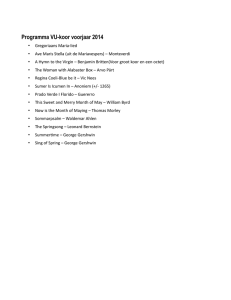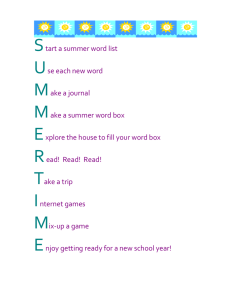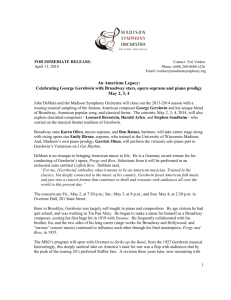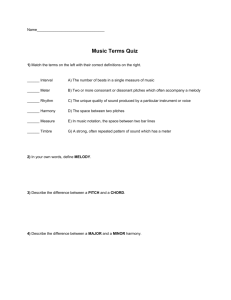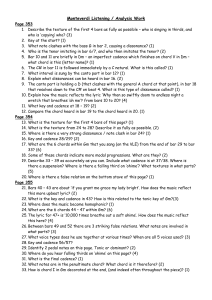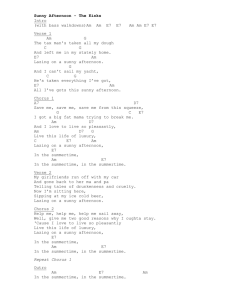Gershwin - Nick Redfern
advertisement
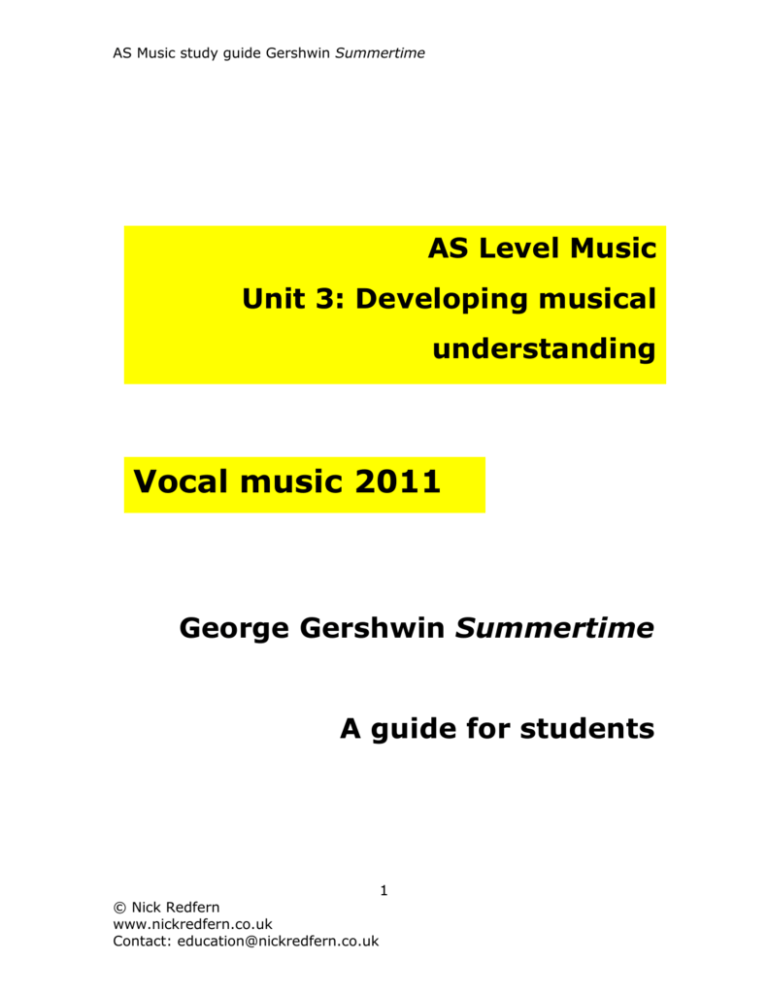
AS Music study guide Gershwin Summertime AS Level Music Unit 3: Developing musical understanding Vocal music 2011 George Gershwin Summertime A guide for students © Nick Redfern www.nickredfern.co.uk Contact: education@nickredfern.co.uk 1 AS Music study guide Gershwin Summertime Developing musical understanding works for 2011 .... 3 Instrumental music ........................................................................... 3 Vocal music ....................................................................................... 3 About this document ......................................................................... 3 The exam ........................................................................................... 4 Gershwin .................................................................... 5 Text ............................................................................ 5 Setting ....................................................................... 5 Structure .................................................................... 5 The score.................................................................... 6 Harmony .................................................................... 6 Introduction ...................................................................................... 6 Verse 1 .............................................................................................. 8 Chromaticism .................................................................................. 10 Texture..................................................................... 12 Melody...................................................................... 13 Swung time ..................................................................................... 14 Orchestration ........................................................... 15 © Nick Redfern www.nickredfern.co.uk Contact: education@nickredfern.co.uk 2 AS Music study guide Gershwin Summertime Developing musical understanding works for 2011 Instrumental music Bach Sarabande & Gigue from Partita in D Haydn String Quartet The Joke, movement 4 Webern Quartet Op. 22, movement 1 Tippett Concerto for Double String Orchestra Vocal music Dowland Flow my tears Bruckner Locus iste Gershwin Summertime Berio Sequenza III for female voice Cliff You can get it if you really want Gallagher Don’t look back in anger About this document This document is designed to support the study of AS Level Music (edexcel) Unit 3 Developing musical understanding, Vocal Music. The guide is available at www.nickredfern.co.uk and is produced in conjunction with student workbooks, PowerPoint documents and other related material. I have tried not to include detail which is extraneous to the exam, such as dates and biographical detail, analysis of text, etc. For further information or enquiries education@nickredfern.co.uk © Nick Redfern www.nickredfern.co.uk Contact: education@nickredfern.co.uk 3 please contact me at AS Music study guide Gershwin Summertime The exam There are two questions which relate to the set works which are constant in format. Part B: Investigating Musical Styles (b) Vocal Music (i) Describe the stylistic features of XXXXX (one of the set works) which show that this is an example of XXXXX (style/period/era) (10) (ii) Compare and contrast the XXXXX and XXXXX (two compositional devices: harmony, tonality, melody, structure, vocal writing, texture and word setting) of XXXXX and XXXXX (two different set works) (18) © Nick Redfern www.nickredfern.co.uk Contact: education@nickredfern.co.uk 4 AS Music study guide Gershwin Summertime Gershwin George Gershwin, American composer and pianist (1898 – 1937, was a prolific composer of songs, musicals and operas. The Opera, Porgy and Bess, from which Summertime is taken, was first performed in 1935. Text Summertime an’ the livin’ is easy, Fish are jumpin’, an’ the cotton is high. Oh yo’ daddy’s rich, and yo’ ma is good lookin’, So hush, little baby, don’ yo’ cry. One of these mornin’s you goin’ to rise up singin’, Then you’ll spread yo’ wings an’ you’ll take the sky. But ‘till that mornin’ there’s notnin’ can harm you With daddy an’ mammy standin’ by. Setting The setting of the text is almost entirely syllabic, that is one note per syllable. Structure Introduction bars 1 – 7. The vocal part begins on an anacrusis, or an upbeat. Verse 1: bars 7, beat 3 – 24 Verse 2: bars 25 – 46 (Coda bars 41 – 46) © Nick Redfern www.nickredfern.co.uk Contact: education@nickredfern.co.uk 5 AS Music study guide Gershwin Summertime The score The score is a piano reduction of an orchestral score which does not truly represent the music of the recording. For the purpose of this document I will refer generally to the score alone. Harmony Introduction The octave unison texture of the introduction is triadic. Bar 1 outlines a diminished tonic, B diminished chord (the key of the main body of music is B minor). The Fª, a flattened 5th of the tonic chord, acts as a blues note and immediately signals a strong stylistic trait of this blues infused music. In bar 2 the F# is established and the B minor tonic is established. Here an F# dominant pedal is established. In bars 3 and 4 the descending quaver pattern falls in thirds, which also implies harmony. Here the harmony implied is a B minor 13, which is an extended chord, or a triad with additional thirds added above the 7th, and is indicative of the jazz style of the harmony. The chord is rich and sonorous and contributes to the sensuous and evocative feel of the introduction. © Nick Redfern www.nickredfern.co.uk Contact: education@nickredfern.co.uk 6 AS Music study guide Gershwin Summertime The ostinato on F# and G# in bar 4, beats 3 to bar 4 is in crotchets and augmented to minims in bars 6 -7 and echoes in the bells are the sharpened 6th & 7th degrees of B minor, the A# being the leading note. This ostinato therefore has the effect of preparing the statement of the tonic minor at bar 8. © Nick Redfern www.nickredfern.co.uk Contact: education@nickredfern.co.uk 7 AS Music study guide Gershwin Summertime Verse 1 The harmonic language of the verse is characterised by the employment of chords with added notes. In bars 8 – 11 a harmonic ostinato is established, painting in music the act of gently rocking a sleeping baby. This work is, after all, a lullaby. The two minim chords are B minor with an added sharpened 6th and C# minor with an added sharpened 6th. Chord ostinato Chords represented in one octave These chords, written in parallel motion, or moving by step whilst maintaining their shape. Parallel motion was a stylistic trait of the French composers Debussy and Ravel. Gershwin was highly influenced by European modern music and did try and obtain composition lessons from Ravel. The sharp 6th is a stylistic characteristic of the French school and also the emerging Jazz style of harmony. © Nick Redfern www.nickredfern.co.uk Contact: education@nickredfern.co.uk 8 AS Music study guide Gershwin Summertime Bars 12 – 13 have a change in harmonic expression, with an ascending pattern of rich, Blues informed chords. The chromatic embellishments add to the languid feel to the music, represented here by circles. In reduction the exact nature of the harmony is revealed. E minor 7 E minor 7 Em G^7 G^7 E# dim 7 1st inv. 2nd inv. Inversion © Nick Redfern www.nickredfern.co.uk Contact: education@nickredfern.co.uk B pedal 9 1st inv.1st inv. 2nd inv. AS Music study guide Gershwin Summertime At bars 14 = 15 the chromatic language which characterises the work and Gershwin’s harmonic idiom is stated fully. The use of blues notes or false relations lends the work an expressive dissonant bite: bar 14 F# - Fª and E# - Eª; bar 15 Dª - D#. Chromaticism The harmonies of this moment are quite exquisite. Here they are represented in reduction. F# 1st inversion C#7 maj/min 10 © Nick Redfern www.nickredfern.co.uk Contact: education@nickredfern.co.uk F# D#m7 F#¨5/7 3rd inv 2nd inv. AS Music study guide Gershwin Summertime At bar 19 there occurs yet another example of Gershwin’s exotic harmonic language. The ascending whole tone scale ensuring the E¨7 chord of beat 3 has an added dissonance, a sharpened 4th. The melody then raises a minor third to add a sharp 6th to the chord. The F# of the vocal melody adds a further 9th to the colour of the chord. Here are the chords in reduction: The complexity of the chord is diluted through the spacing of the notes throughout three octaves. The final cadence of verse 1 reveals yet more complex harmonies. The melody of bar 20 clearly outlines a B minor 7, as does the bass, which is an example of heterophony (see Texture) Bar 21: E major to A major 11 (no 3rd or 5th) Bar 21: B minor (tonic) This VII 11 to I cadence is highly effective. 11 © Nick Redfern www.nickredfern.co.uk Contact: education@nickredfern.co.uk AS Music study guide Gershwin Summertime A major 11 (no 3rd or 5th) A major 11 (complete) As the work is strophic there is no variation in the harmony of the individual verses until bar 41, the Coda. E A 11 D G 11 C F# #6/7 Bm The combined affect of the tonic pedal in the Soprano, the cycle of fifths in the Bass, the extended 11th chords and the Blues cadence results in powerful and highly functional harmony. The chromaticism of the chord progression is evident in the top note of each chord, whose chromatic decent is expressive and enhances greatly the directional quality of the progression. Texture Homophonic. The first two bars are in octave unison in the score and at bar 20 there is a brief example of heterophony. This is where the melody occurs in one or more independent parts simultaneously but in variation. There both parts outline the chord of Bm7. 12 © Nick Redfern www.nickredfern.co.uk Contact: education@nickredfern.co.uk AS Music study guide Gershwin Summertime The counter melody of bars 26 - 37, beat 1 does offer very brief moments of heterophony, but these are too insignificant to warrant further investigation. However, the countermelody does bring some contrapuntal interest to the passage. Melody The melody is not pentatonic but clearly based on a 6 note scale with the semitone between the 2nd and 3rd degrees. 13 © Nick Redfern www.nickredfern.co.uk Contact: education@nickredfern.co.uk AS Music study guide Gershwin Summertime The narrow range of the melody sits within an octave between F# and F#: The range is a stylistic allusion to the Black American folk music of the late 19th and early 20th Century as is the pentatonic feel to the modality. The leading note (A) is a tone or major second from the tonic (B) which is typical of the Blues mode. The use of a portamento at bar 21 is also a stylistic allusion to Black American folk music. Swung time Swung time is a method of rhythmic interpretation which alters pairs of quavers or dotted quaver + semiquaver into a triplet of a crotchet + quaver. Here is verse one in swung time as sung by the Soprano on the NAM recording. This is a stylistic allusion to jazz and blues where this is a common feature. 14 © Nick Redfern www.nickredfern.co.uk Contact: education@nickredfern.co.uk AS Music study guide Gershwin Summertime Bar 12 Here, at bar 12 the triplets are notated. Orchestration As the score is represented in piano reduction discussion of the scoring is not really feasible. However, the addition of a wordless chorus at bar 26 does extend the colouristic range of the orchestra. Bars 30 - 33 However, there material is a simple doubling of the orchestral chords. Where the wordless chorus does make a significant impact is the manner in which the upper Soprano enhances the chromatic decent of the cycle of fifths chord progression at bars 41 – 44 of the Coda. 15 © Nick Redfern www.nickredfern.co.uk Contact: education@nickredfern.co.uk
